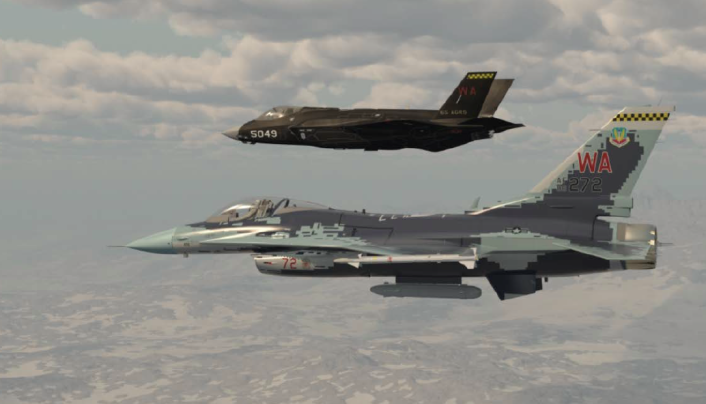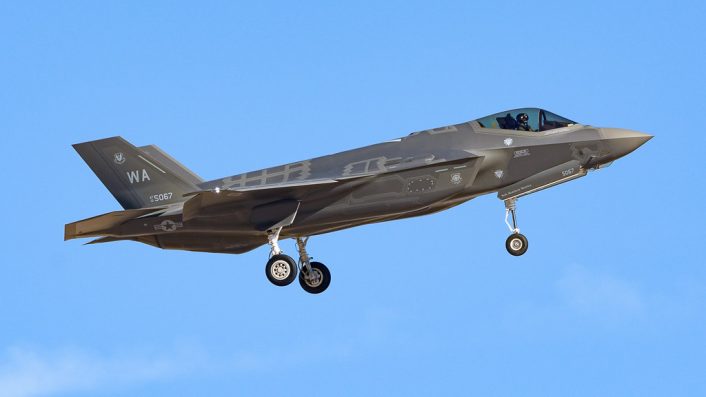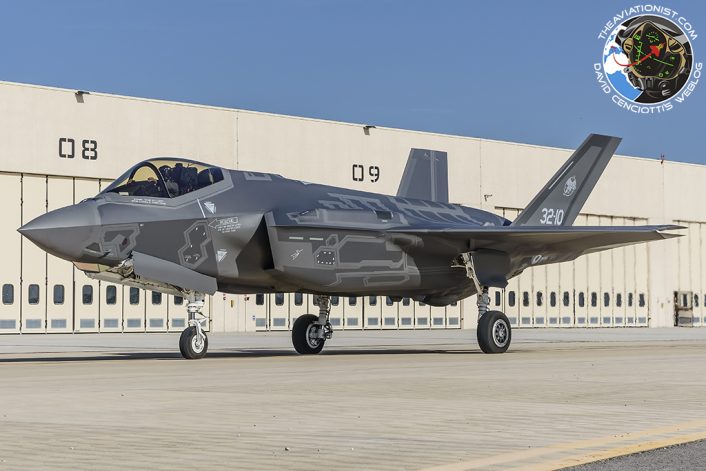The unit, inactivated in September 2014 due to budget constraints imposed by sequestration, is going to “resurrect” and fly the 5th generation aircraft.
On May 9, the U.S. Air Force announced the plan to reactivate the 65th Aggressor Squadron (65th AGRS) and move 11 F-35A Lightning IIs to Nellis Air Force Base, Nevada, “as part of a larger initiative to improve training for fifth generation fighter aircraft.”
According to an official public release, “the action came after Gen. Mike Holmes, Air Combat Command commander, recommended improving training for fifth generation fighter tactics development and close-air support by adding F-35s to complement the fourth generation aircraft currently being used. To support this requirement, the Air Force decided to create a fifth generation aggressor squadron at Nellis AFB and move nine non-combat capable F-35A aircraft from Eglin AFB, Florida, to the squadron.”
Indeed, the emergence of a “stealth threat” among the “enemy lines” (i.e. China and Russia) makes the choice quite wise: for the next 10-15 years the majority of the U.S. aircraft will be “legacy” ones (NATO says 70 percent of its fleet), hence it is important for both the 4th and the 5th generation aircraft to learn how to face other stealth aircraft in combat. And early production F-35s, aircraft that would be too expensive to upgrade to a mission capable status, are perfect for the role.

“Aggressor squadrons have been honing the skills of Air Force pilots since the early 1970s,” said Air Force Chief of Staff Gen. David L. Goldfein. “They provide a dose of realism in air exercises and their training value is crucial. These F-35 aggressor aircraft will keep us ahead of adversaries for years to come.”
Aircraft transferring from Eglin AFB to Nellis AFB will not occur until newly produced aircraft arrive at Eglin AFB to replace them. New aircraft are planned to arrive at Nellis AFB beginning in early 2022, the U.S. Air Force said in the official website.
An F-35 playing the adversary role would bring the Aggressors lethality to a complete new level. Just think to one think to one of the elements of discontinuity of 5th generation technology if compared to the 4th gen. fighters: Sensor Fusion. The aircraft of previous generations had the ability to carry a wide variety of sensors, each of which represented (and still represents) an interface to the real world: they provide an interpretation of reality, in a specific place and time.
The proliferation of sensors on a “legacy” aircraft clashes with the limited cognitive and processing capacity of a human being. Each sensor exposes its representations to the extent that the pilot is able to interpret them. In other words putting the live feeds coming from 100 surveillance cameras in front of a person’s eyes would be useless because the only effect would be to saturate the person’s attention: at a certain point, whoever is placed in front of a large amount of images would cease to process them. The added value of 5th generation technology is the ability to transform the data collected by the various sensors into information relevant to the pilot at that precise moment.

“The information gathered by the aircraft from different sources must be summarized and weighed: an extremely dynamic interface, continuously and in real-time, evaluates the weight of the information it receives to build a picture, or a representation of the surrounding reality, relevant to the carried out mission, and suitable for learning and processing by a man. The fusion engine is much more advanced than a filter that cuts unnecessary information; it is an embryo of Artificial Intelligence, which carries out the “blend” of sensors by bringing out only what is relevant at that precise moment, freeing up a portion of the cognitive capacity that the pilot can use to perform other tasks” told me Col. Davide Marzinotto, Italian Air Force 32° Stormo (Wing) commander in a recent interview.
The Sensor Fusion allows the DAS, the AESA radar and the Electronic Warfare Suite (EWS) to generate a “picture” of the scenario in which the aircraft is operating which is sent to the helmet so that the pilot only has the information strictly necessary for the mission management. The goal is to enable the pilot to close the OODA (observe – orient – decide – act) loop as quickly as possible.

For example, if the F-35 is flying in enemy airspace the Sensor Fusion enables or disables a certain sensor or points it in the right direction in order to draw a tactical picture of the situation that is relevant to the current mission. If, during a mission, the F-35 detects the signal emitted by an enemy radar at a distance that does not constitute a threat, the on-board computer will acquire its position but will not communicate its presence to the pilot in order not to distract him with a irrelevant information: the data will however be saved because it is useful for updating the opponent’s EOB (Electronic Order of Battle), but the existence and location of the emitter will not be highlighted on the map since it is not relevant to the current mission. As you may understand, this is (just) one of the reasons why the F-35 is emerging as an extremely fearsome adversary in an air-to-air scenario.
While the news is great, it’s not clear whether the F-35s will ever be given a special livery, as happens to the F-16s of the 64th and 18th AGRS (the F-15s of the 65th AGRS before it was disbanded were also painted in striking color schemes). The LO (Low Observability) coating is one of the aircraft’s most delicate components and, for the moment, no F-35 was ever given anything more exotic than the standard haze paint of the stealth aircraft and some high-visibility tail markings.
Eye-catching paint schemes which make fighter planes similar to their Russian or Chinese counterparts are the distinguishing feature of U.S. Aggressors and Adversary jets. Red Air liveries replicate the paint schemes, markings and insignas of their near peer adversaries, so that pilots in training who come within visual range of these adversary jets get the same sight they would see if they were engaging an actual threat. Some famous “splinter” patterns worn by Nellis AFB’s Aggressors as well as more “traditional” camouflages, like the one applied to U.S. Marine Corps F/A-18 Hornets in the last years, have been inspired by Russian Air Force and Navy aircraft.
Noteworthy, some months ago, the commander of Nellis 57th Wing, Brig. Gen. Robert Novotny, crowdsourced the new adversary livery to be applied to one of the 64th Aggressor Squadron’s F-16C in the need of a new paint job. Through his Facebook page, Novotny let the social media vote on several color schemes, some of those based on existing patterns, others designed by the users, narrowing down the choices and helping them picking the new pattern.
After a few rounds of polls, likes and comments, the winner was the same pixelated camouflage of the Russian Sukhoi Su-57 stealth jet.
When the winner was announced in January 2019, Novotny also shared some nice renderings, including two showing an F-35A with 64th AGRS markings and black livery, much similar to the paint job used on the early J-20s and J-31 prototypes.
Who knows? Maybe in the future we will see something like that outside of Nellis AFB.








